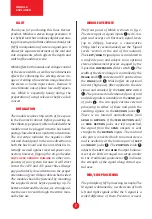
4
DIMeNSION effeCt
Mińsk offers two methods of adding a feeling
of dimension to the audio signal. It may be
used either for enhancing the existing ste-
reo pair or for creating a faux stereo image
from a mono source patched into the left/
mono input. Please note, the effect is most
noticeable with complex and dynamic audio
content.
The dimension a variant is based on the Haas
effect. A short and very slowly varying delay is
introduced between the left and right channels.
This varying delay confuses the human audito-
ry system that relies on an inter-aural time dif-
ference to locate sources in the stereo field. In
practice, it translates to a subtle animation of
the stereo image that is in constant motion and
thus perceived as “ethereal”.
The dimension b variant is based on early
reflections as present in most reverberant
spaces. In recording techniques that capture
an acoustic scene by using multiple micro-
phones, the perception of spaciousness relies
mostly on the presence of wall reflections.
We simulate this effect in Mińsk using an ER
network from popular algorithmic reverbs.
Its output is mixed with the side signal and
the degree of spaciousness is adjusted with
the image control.
lOW Cut fIlter (SIDe HPf)
Eliminating off-axis low end is a common re-
quirement for vinyl cutting and other media.
Mińsk facilitates this by applying a high pass
filter to the S component. The switch offers
three settings: 300, 50 and off. At 300Hz,
the filter slope is 12dB/oct, while the 50Hz
setting uses a steeper 24dB/oct slope. Please
keep in mind, this filter does not affect the M
component, therefore its impact on the tonal
balance should be marginal (unless the mix
is rather unorthodox).
StereO IMaGe WIDtH CONtrOl
The center image knob and the respective CV
input control the width of the stereo image
by applying a variable gain to both the M
and S components.
With no CV at the input, the middle position
of the knob (marked mid+side) does not af-
fect the signal. When turned CCW it reduces
the amplitude of the S component thus nar-
rowing the perceived image down to mono.
When turned CW from the middle, it increases
the gain of the S component while simultane-
ously reducing the gain of the M component to
maintain the overall signal energy. This artifi-
cially widens the stereo image while creating
a hole in the middle of the scene. At the maxi-
mum (2∙side) position there is only S and no
M, which translates to the L and R signals be-
ing entirely out of phase. This setting should
be used very carefully because such a signal is
not compatible with mono reproduction and
will sound bad on many PA systems.
With a CV source patched to the image in-
put, the image knob acts as an offset, i.e.
the incoming CV adds to the position of the
knob. The range of 0-10V corresponds to
turning the image knob from mid through
mid+side to 2∙side. With the knob in the
mid+side position, a bipolar ±5V signal is
needed for full range modulation. With the
knob set at mid, bipolar modulation moves
the side component through zero —negative
values yield mirroring of the stereo image (L
and R are flipped).






